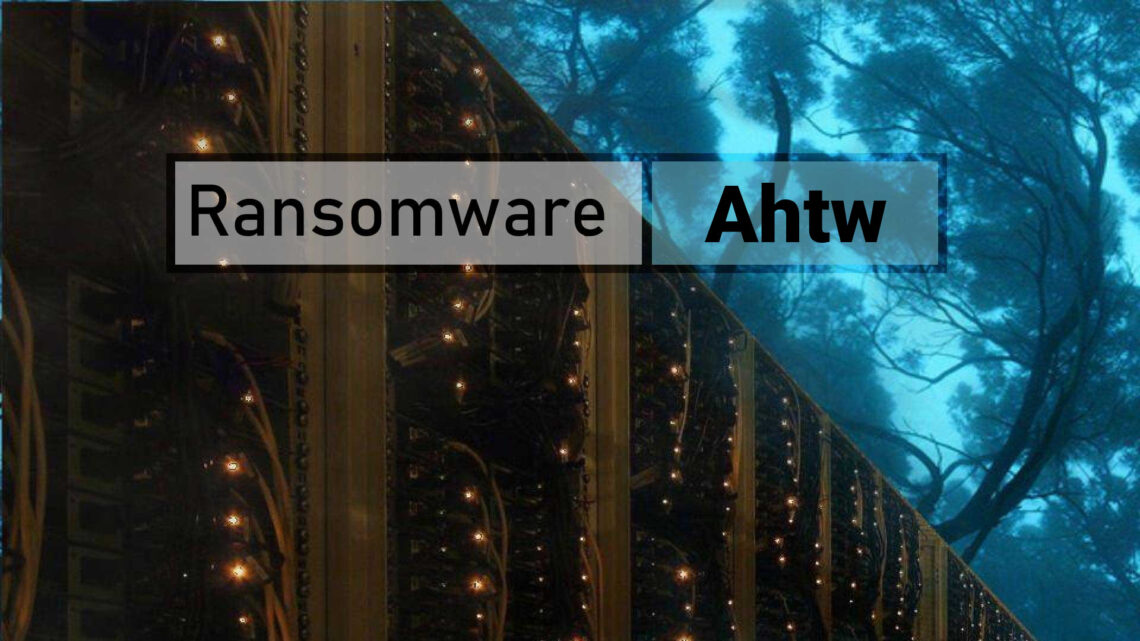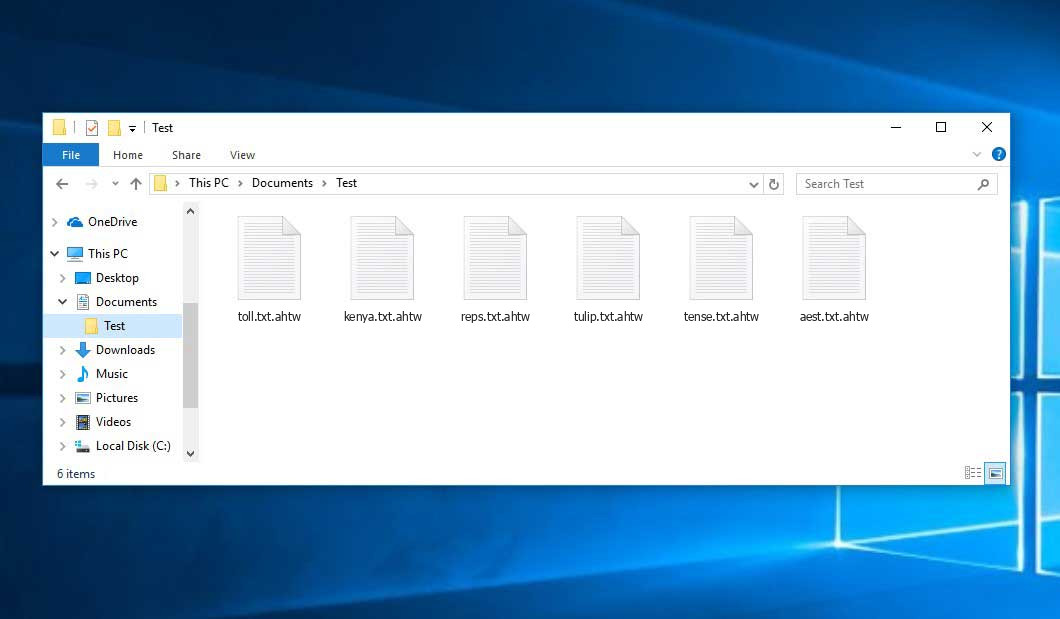What is Ahtw virus?
Ahtw virus is a ransomware associated with the STOP/Djvu family, encrypts files on the victim’s computer and demands a ransom for the decryption tools. Our team discovered Ahtw while analyzing recently submitted malware samples on the VirusTotal platform. It’s important to note that this ransomware can be distributed alongside other malware, such as RedLine or Vidar.
Once this ransomware a computer, it adds the “.ahtw” extension to the filename of each encrypted file. For instance, a file named “1.jpg” becomes “1.jpg.ahtw“, “2.doc” transforms into “2.doc.ahtw“, and so on. Moreover, the ransomware generates a ransom note called “_readme.txt“.
I have prepared a comprehensive list of potential solutions, tips, and techniques that can help you effectively combat the Ahtw virus and recover your encrypted files. While in some cases file restoration can be a straightforward process, there are instances where retrieving the files may pose significant challenges.
Ahtw
🤔 Ahtw virus is ransomware that originates from the DJVU/STOP family. Its primary purpose is to encrypt files that are important for you. After that ransomware virus asks its victims for a ransom fee ($490 – $980) in BitCoin.
The Ahtw virus employs a unique encryption key for each victim; however, there is a limitation to its encryption method:
- If the Ahtw virus is unable to establish a connection with its command and control server (C&C Server) before starting the encryption process, it utilizes offline keys. These offline keys are the same for all victims, providing a potential avenue for decrypting files encrypted in a ransomware attack.
Ahtw virus is basically similar to other the same DJVU family: Ahui, Neqp, Nerz. The image below gives a clear vision of how the files with “.ahtw” extension look like:
| Name | Ahtw Virus |
| Ransomware family1 | DJVU/STOP2 ransomware |
| Extension | .ahtw |
| Ransomware note | _readme.txt |
| Ransom | From $490 to $980 (in Bitcoins) |
| Contact | support@fishmail.top, datarestorehelp@airmail.cc |
| Detection | KillMBR.Trojan.MBRKiller.DDS, Trojan-PSW.Win32.Coins.pef, Win32:VB-ABLQ [Trj] |
| Symptoms |
|
| Fix Tool | To remove possible malware infections, scan your PC: 6-day free trial available. |
This text asking payment is for restore files via decryption key:
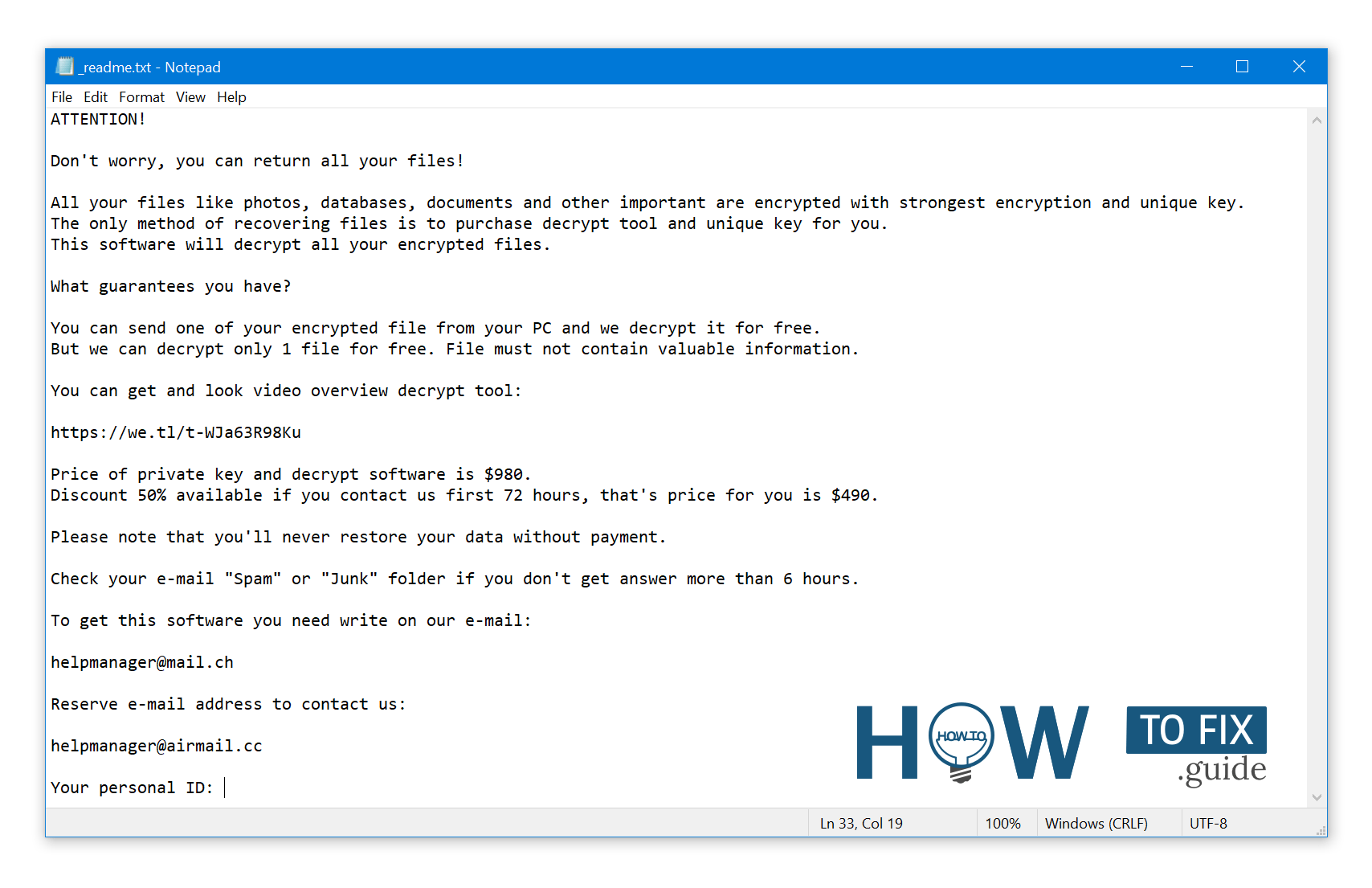
_readme.txt (STOP/DJVU Ransomware) – The scary alert demanding from users to pay the ransom to decrypt the encoded files contains these frustrating warnings
The Ahtw ransomware carries out a series of processes to execute various tasks on the victim’s computer. One of the initial processes is winupdate.exe, which presents a deceptive Windows update prompt to the victim during the attack. This misleading tactic aims to make the victim believe that a sudden system slowdown is caused by a legitimate Windows update. Concurrently, another process with a randomly generated four-character name scans the system for target files and encrypts them. Additionally, the ransomware executes the following CMD command to delete Volume Shadow Copies:
vssadmin.exe Delete Shadows /All /Quiet
By removing the Volume Shadow Copies, the ransomware prevents the victim from restoring the computer to a previous state using System Restore Points. Ransomware operators deliberately eliminate Windows OS-based methods that could potentially aid in file restoration free of charge. Furthermore, the ransomware modifies the Windows HOSTS file by adding a list of domains and mapping them to the localhost IP. Consequently, when the victim tries to access any of the blocked websites, they will encounter a DNS_PROBE_FINISHED_NXDOMAIN error.
We observed that the ransomware attempts to block websites that provide instructional guides for computer users. This indicates that the cybercriminals aim to hinder the victim’s access to relevant and helpful information regarding ransomware attacks by restricting specific domains. The virus also creates two text files on the victim’s computer, bowsakkdestx.txt and PersonalID.txt, which contain attack-related details such as the victim’s public encryption key and personal ID.
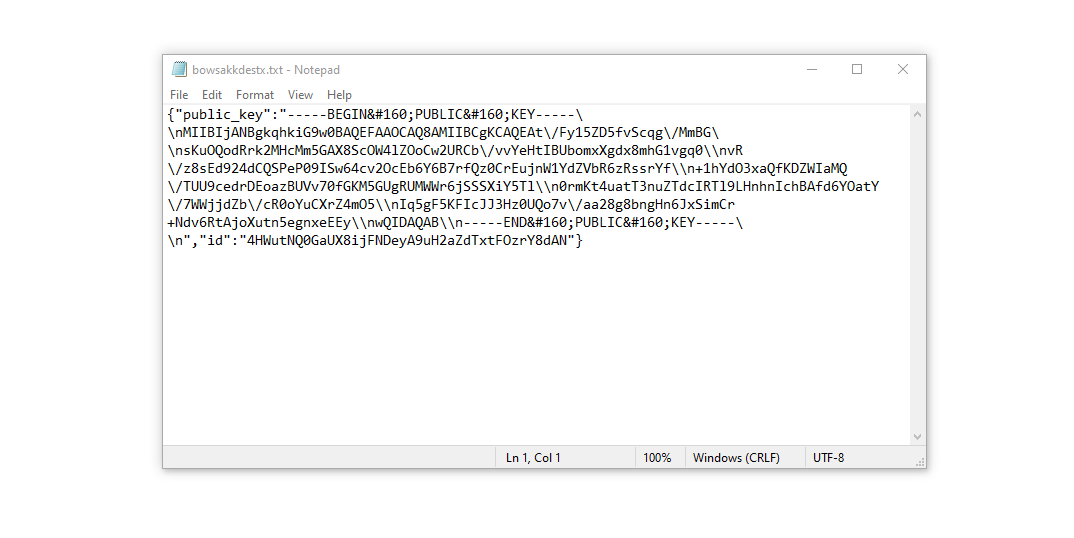
After implementing these modifications, the malware continues to wreak havoc. Variants of the STOP/DJVU ransomware are known to deploy the Vidar password-stealing Trojan on compromised systems, which possesses an extensive range of capabilities, including:
- Stealing login credentials for platforms like Steam, Telegram, and Skype.
- Targeting cryptocurrency wallets for theft.
- Downloading and executing malware on the infected computer.
- Extracting sensitive information such as browser cookies, saved passwords, and browsing history.
- Accessing and manipulating files on the victim’s computer.
- Granting hackers remote control over the victim’s computer for various malicious activities.
The DJVU/STOP ransomware family employs the AES-256 encryption algorithm. Consequently, when malware encrypted the files using an offline decryption key, which is entirely unique, the unfortunate truth is that decrypting the files becomes an impossible task.
In the event that the Ahtw virus operated in online mode, gaining access to the AES-256 key becomes an unattainable feat. Hackers that stand behind the ransomware keep the key on their server.
To obtain the decryption key, victims should pay $980 and contact the hackers by the email address from the ransom note (support@fishmail.top).
The message by the ransomware states the following information:
ATTENTION! Don't worry, you can return all your files! All your files like photos, databases, documents and other important are encrypted with strongest encryption and unique key. The only method of recovering files is to purchase decrypt tool and unique key for you. This software will decrypt all your encrypted files. What guarantees you have? You can send one of your encrypted file from your PC and we decrypt it for free. But we can decrypt only 1 file for free. File must not contain valuable information. You can get and look video overview decrypt tool: https://we.tl/t-WJa63R98Ku Price of private key and decrypt software is $980. Discount 50% available if you contact us first 72 hours, that's price for you is $490. Please note that you'll never restore your data without payment. Check your e-mail "Spam" or "Junk" folder if you don't get answer more than 6 hours. To get this software you need write on our e-mail: support@fishmail.top Reserve e-mail address to contact us: datarestorehelp@airmail.cc Your personal ID: XXXXXXXXXXXXXXXXXXXXXXXXXXXXXXX
Do not pay for ransom!
Please, try to use the available backups, or Decrypter tool
The _readme.txt file also indicates that the computer owners must get in touch with the Djvu ransomware representatives during 72 hours starting from the moment of files encryption. On the condition of getting in touch within 72 hours, users will have to pay only a half of the sum. Thus the ransom amount will be minimized down to $490. Yet, stay away from paying the ransom!
I insist that you do not contact these crooks and do not pay. The one of the most real working solution to recover the lost data – just using the available backups, or use Decrypter tool.
The peculiarity of all such viruses apply a similar set of actions for generating the unique decryption key to recover the ciphered data.
Thus, unless the ransomware is still under the stage of development or possesses with some hard-to-track flaws, manually recovering the ciphered data is a thing you can’t perform. The only solution to prevent the loss of your valuable data is to regularly make backups of your crucial files.
Note that if you do have regular backups, it is important to store them in a dedicated location separate from your main workstation, rather than keeping them connected to it.
For example, you can store the backup on a USB flash drive or an external hard drive. Alternatively, consider using online (cloud) storage services for your backup data.
It goes without saying that if you keep your backup data on your regular device, it is susceptible to encryption just like any other data.
For this reason, locating the backup on your main computer is surely not a wise idea.
How I was infected?
Ransomware has a various methods to built into your system. But it doesn’t really matter what way had place in your case.

Ransomware attack following a successful phishing attempt.
- hidden installation along with other apps, especially the utilities that work as freeware or shareware;
- dubious link in spam emails leading to the virus installer
- online free hosting resources;
- using illegal peer-to-peer (P2P) resources for downloading pirated software.
There were cases when the Ahtw virus was hiding as some legitimate tool, for example, in the messages demanding to initiate some unwanted software or browser updates. This is typically the way how some online frauds aim to force you into installing the ransomware manually, by actually making you directly participate in this process.
Indeed, the fake update alert will not explicitly indicate that you are about to install the virus. Instead, it will have a disguise of, for example, an alert prompting you to update a program like Adobe Flash Player or another suspicious software.
Of course, the cracked apps represent the damage too. Using P2P is both illegal and may result in the injection of serious malware, including the Ahtw ransomware.
To sum up, what can you do to avoid the injection of the Ahtw ransomware into your device? Even though there is no 100% guarantee to prevent your PC from getting damaged, there are certain tips I want to give you to prevent the penetration. You must be cautious while installing free software today.
Make sure you always read what the installers offer in addition to the main free program. Stay away from opening dubious email attachments. Do not open files from the unknown addressees. And, of course, keep your security software up to date.
The malware does not speak openly about itself. It will not be mentioned in the list of your available programs. However, it will be masked under some malicious process running regularly in the background, starting from the moment when you launch your computer.
How To Remove Ahtw Virus?
In addition to encode a victim’s files, the Ahtw infection has also started to install the Vidar Stealer on computer to steal account credentials, cryptocurrency wallets, desktop files, and more.3
Reasons why I would recommend GridinSoft4
There is no better way to recognize, remove and prevent ransomware than to use an anti-malware software from GridinSoft5.
Remove Ahtw virus with Gridinsoft Anti-Malware
We have also been using this software on our systems ever since, and it has always been successful in detecting viruses. It has blocked the most common Ransomware as shown from our tests with the software, and we assure you that it can remove Ahtw virus as well as other malware hiding on your computer.

To use Gridinsoft for remove malicious threats, follow the steps below:
1. Begin by downloading Gridinsoft Anti-Malware, accessible via the blue button below or directly from the official website gridinsoft.com.
2.Once the Gridinsoft setup file (setup-gridinsoft-fix.exe) is downloaded, execute it by clicking on the file.

3.Follow the installation setup wizard's instructions diligently.

4. Access the "Scan Tab" on the application's start screen and launch a comprehensive "Full Scan" to examine your entire computer. This inclusive scan encompasses the memory, startup items, the registry, services, drivers, and all files, ensuring that it detects malware hidden in all possible locations.

Be patient, as the scan duration depends on the number of files and your computer's hardware capabilities. Use this time to relax or attend to other tasks.
5. Upon completion, Anti-Malware will present a detailed report containing all the detected malicious items and threats on your PC.

6. Select all the identified items from the report and confidently click the "Clean Now" button. This action will safely remove the malicious files from your computer, transferring them to the secure quarantine zone of the anti-malware program to prevent any further harmful actions.

8. If prompted, restart your computer to finalize the full system scan procedure. This step is crucial to ensure thorough removal of any remaining threats. After the restart, Gridinsoft Anti-Malware will open and display a message confirming the completion of the scan.
Remember Gridinsoft offers a 6-day free trial. This means you can take advantage of the trial period at no cost to experience the full benefits of the software and prevent any future malware infections on your system. Embrace this opportunity to fortify your computer's security without any financial commitment.
Trojan Killer for “Ahtw virus” removal on locked PC
In situations where it becomes impossible to download antivirus applications directly onto the infected computer due to malware blocking access to websites, an alternative solution is to utilize the Trojan Killer application.

There is a really little number of security tools that are able to be set up on the USB drives, and antiviruses that can do so in most cases require to obtain quite an expensive license. For this instance, I can recommend you to use another solution of GridinSoft - Trojan Killer Portable. It has a 14-days cost-free trial mode that offers the entire features of the paid version. This term will definitely be 100% enough to wipe malware out.
Trojan Killer is a valuable tool in your cybersecurity arsenal, helping you to effectively remove malware from infected computers. Now, we will walk you through the process of using Trojan Killer from a USB flash drive to scan and remove malware on an infected PC. Remember, always obtain permission to scan and remove malware from a computer that you do not own.
Step 1: Download & Install Trojan Killer on a Clean Computer:
1. Go to the official GridinSoft website (gridinsoft.com) and download Trojan Killer to a computer that is not infected.

2. Insert a USB flash drive into this computer.
3. Install Trojan Killer to the "removable drive" following the on-screen instructions.

4. Once the installation is complete, launch Trojan Killer.
Step 2: Update Signature Databases:
5. After launching Trojan Killer, ensure that your computer is connected to the Internet.
6. Click "Update" icon to download the latest signature databases, which will ensure the tool can detect the most recent threats.

Step 3: Scan the Infected PC:
7. Safely eject the USB flash drive from the clean computer.
8. Boot the infected computer to the Safe Mode.
9. Insert the USB flash drive.
10. Run tk.exe
11. Once the program is open, click on "Full Scan" to begin the malware scanning process.

Step 4: Remove Found Threats:
12. After the scan is complete, Trojan Killer will display a list of detected threats.

13. Click on "Cure PC!" to remove the identified malware from the infected PC.
14. Follow any additional on-screen prompts to complete the removal process.

Step 5: Restart Your Computer:
15. Once the threats are removed, click on "Restart PC" to reboot your computer.
16. Remove the USB flash drive from the infected computer.
Congratulations on effectively removing Ahtw virus and the concealed threats from your computer! You can now have peace of mind, knowing that they won't resurface again. Thanks to Gridinsoft's capabilities and commitment to cybersecurity, your system is now protected.
How To Decrypt .ahtw Files?
Restore solution for big “.ahtw files“
Try removing .ahtw extension on a few BIG files and opening them. Either the Ahtw read and did not encrypt the file, or it bugged and did not add the filemarker. If your files are very large (2GB+), the latter is most likely. Please, let me know in comments if that will work for you.
The newest extensions released around the end of August 2019 after the criminals made changes. This includes Neon, Weqp, Weon, etc.
As a result of the changes made by the criminals, STOPDecrypter is no longer supported. It has been removed and replaced with the Emsisoft Decryptor for STOP Djvu Ransomware developed by Emsisoft.
You can download free decryption tool here: Decryptor for STOP Djvu.
Download and run decryption tool.
Start downloading the decryption tool.
Make sure to launch the decryption utility as an administrator. You need to agree with the license terms that will come up. For this purpose, click on the “Yes” button:
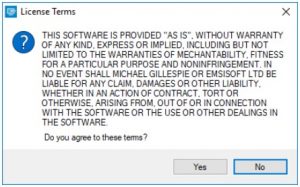
As soon as you accept the license terms, the main decryptor user interface comes up:
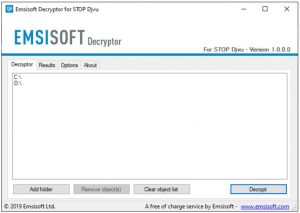
Select folders for decryption.
Based on the default settings, the decryptor will automatically populate the available locations in order to decrypt the currently available drives (the connected ones), including the network drives. Additional locations can be selected with the help of the “Add” button.
Decryptors normally suggest several options considering the specific malware family. The current possible options are presented in the Options tab and can be activated or deactivated there. You may locate a detailed list of the currently active Options below.
Click on the “Decrypt” button.
As soon as you add all the desired locations for decryption into the list, click on the “Decrypt” button in order to initiate the decryption procedure.
Note that the main screen may turn you to a status view, letting you know of the active process and the decryption statistics of your data:
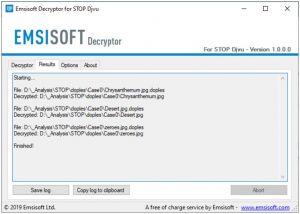
The decryptor will notify you as soon as the decryption procedure is completed. If you need the report for your personal papers, you can save it by choosing the “Save log” button. Note that it is also possible to copy it directly to your clipboard and to paste it into emails or messages here if you need to do so.
The Emsisoft Decryptor might display different messages after a failed attempt to restore your ahtw files:
✓ Error: Unable to decrypt file with ID: [your ID]
✓ No key for New Variant online ID: [your ID]
Notice: this ID appears to be an online ID, decryption is impossible
✓ Result: No key for new variant offline ID: [example ID]
This ID appears be an offline ID. Decryption may be possible in the future.
It can take a few weeks or months until the decryption key gets found and uploaded to the decryptor. Please follow updates regarding the decryptable DJVU versions here.
✓ Remote name could not be resolved
How to Restore .ahtw Files?
In some case Ahtw ransomware is not doom for your files…
The encryption mechanism is next: it encrypts every file byte-by-byte, then saves a file copy, deleting (and not overriding!) the original file. Hence, the information of the file location on the physical disk is lost, but the original file is not deleted from the physical disk. The cell, or the sector where this file was stored, can still contain this file, but it is not listed by the file system and can be overwritten by data that has been loaded to this disk after the deletion. Hence, it is possible to recover your files using special software.
Anyway, after realizing it was an online algorithm, it is impossible to retrieve my encrypted files. I also had my backup drive plugged in at the time of the virus, and this was also infected, or so I thought. Every folder within my backup drive had been infected and was encrypted. However, despite losing some important files, I retrieved almost 80% of my 2TB storage.
When I started going through the folders, I noticed the readme.txt ransom note in every folder. I opened some of the folders and found that all files that were not in a subfolder within that folder had been encrypted. However, I found a flaw and glimmer of hope when I went into the subfolders in other folders and found that these files had not been encrypted. Every folder within my c and d drives, including subfolders, had been encrypted, but this was not the case with the backup drive. Having subfolders created within a folder has saved 80% of my data.
As I said, I believe this to be only a small loophole on a backup drive. I’ve since found a further 10 % of my data on another hard drive on a different pc. So my advice is if you use a backup drive, create subfolders. I was lucky, I guess. But I was also unlucky that the virus hit as I was transferring some files from my backup.
Hopefully, this can help some other people in my situation.
Jamie NewlandRecovering your files with PhotoRec
PhotoRec is a program that originated as an open-source tool for recovering files from damaged disks or for retrieving deleted files. Over time, it has evolved to support the recovery of files with over 400 different extensions, making it suitable for data recovery after a ransomware attack.
To begin, you will need to download this application. It is completely free, although the developer cautions that there is no guarantee of file recovery. PhotoRec is bundled with another utility from the same developer called TestDisk. When you download the archive, it will be named TestDisk, but rest assured that PhotoRec files are included.
To access PhotoRec, locate and open the “qphotorec_win.exe” file. No installation is required, as the program contains all the necessary files within the archive. This means you can store it on a USB drive and use it to assist friends, family, or anyone affected by the DJVU/STOP ransomware.
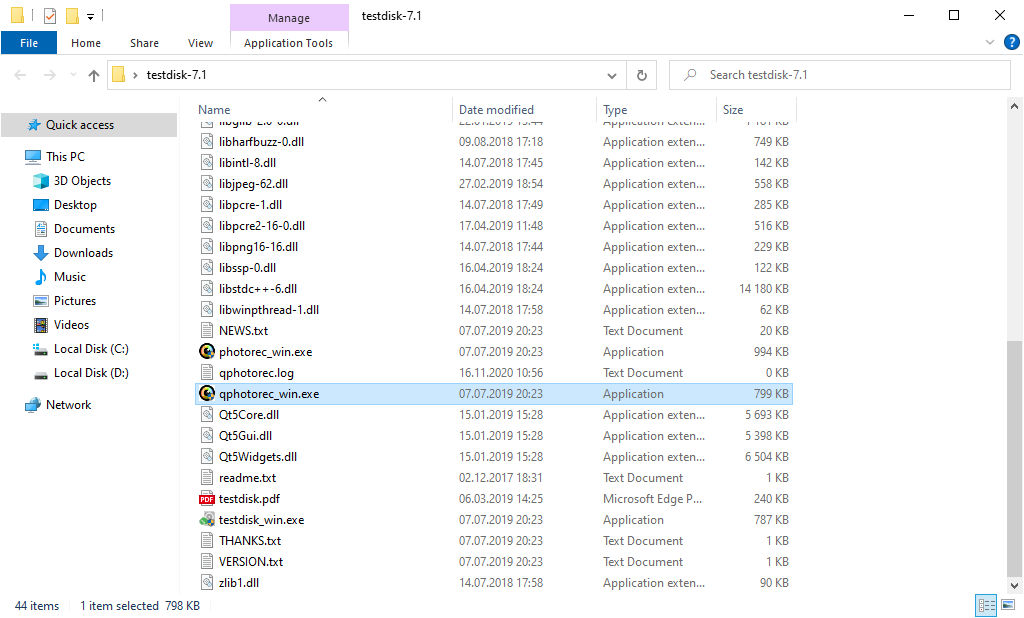
After the launch, you will see the screen showing you the full list of your disk spaces. However, this information is likely useless, because the required menu is placed a bit higher. Click this bar, then choose the disk which was attacked by ransomware.
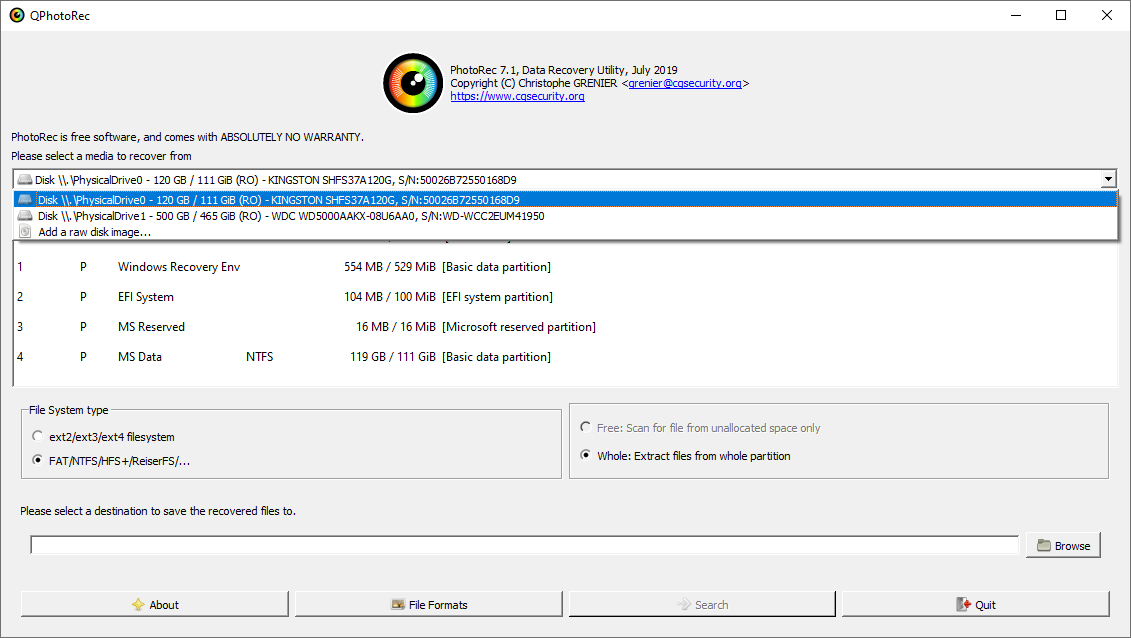
After choosing the disk, you need to choose the destination folder for the recovered files. You will find this menu at the lower part of the PhotoRec window. The best desicion is to export them on USB drive or any other type of removable disk.
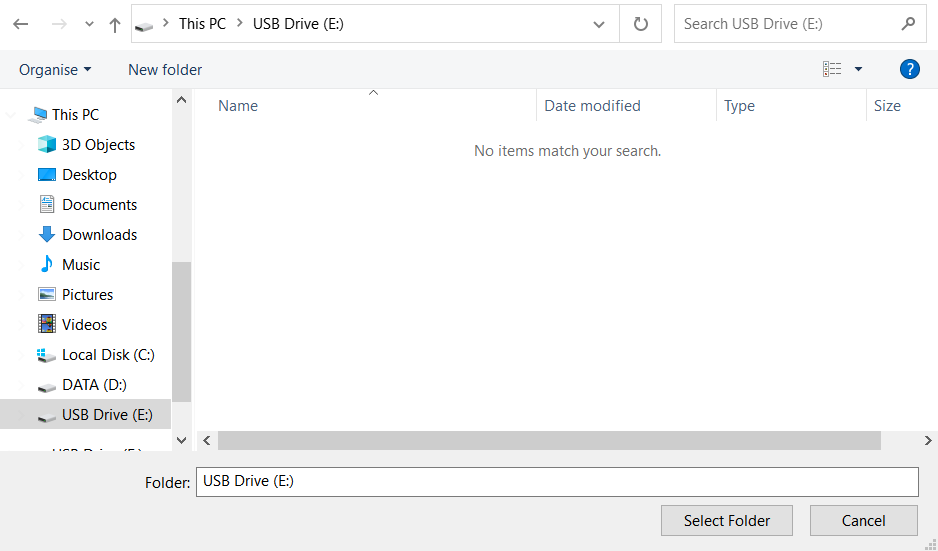
Then, you need to specify the file formats. This option is at the interface bottom, too. As I have mentioned, PhotoRec can recover the files of about 400 different formats.
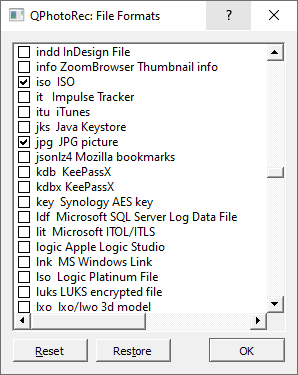
Finally, you can start files recovery by pressing the “Search” button. You will see the window with scan and recovery results.
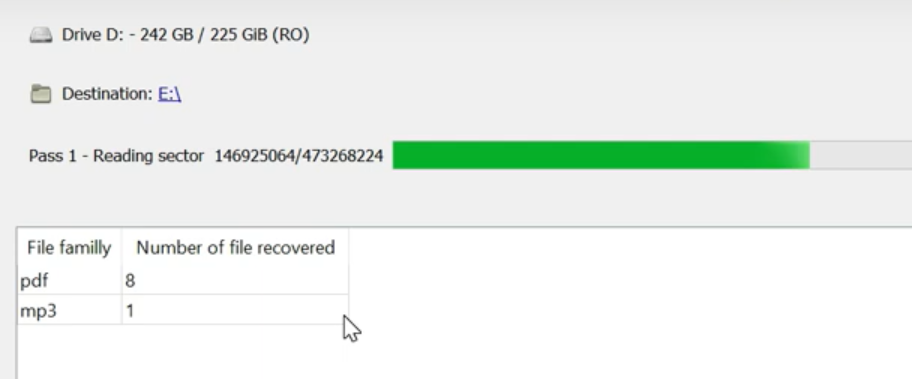
Ahtw files recovery guide
Frequently Asked Questions
No way. These files are encrypted by ransomware. The contents of encrypted files are not available until they are decrypted.
It is highly recommended that you check if you have a backup copy available.
If not, then you can try to restore them through the system function – Restore Point.
All other methods will require patience.
Of course not. Your encrypted files do not pose a threat to the computer. What happened has already happened.
You need GridinSoft Anti-Malware to remove active system infections. The virus that encrypted your files is most likely still active and periodically runs a test for the ability to encrypt even more files. Also, these viruses install keyloggers and backdoors for further malicious actions (for example, theft of passwords, credit cards) often.
In this situation, you need to prepare the memory stick with a pre-installed Trojan Killer.
Have patience. Ahtw is the newest Djvu ransomware variant, and analysts still seek for the decryption keys. Follow the news on our website.
We will keep you posted on when new keys or new decryption programs appear.
The Ahtw ransomware encrypts only the first 150KB of files. So MP3 files are rather large, some media players (Winamp for example) may be able to play the files, but – the first 3-5 seconds (the encrypted portion) will be missing.
You can try to find a copy of an encrypted file:
- Download the files you’ve got from the Internet before the attack.
- Ask people you were sharing the lost data with (pictures, videos, files) to send them back.
- Check out cloud storages if you use ones (Carbonite, OneDrive, iDrive, Google Drive, etc).
- Review attachments in the sent and received emails.
- Files on an older computer, flash drive, external drive, camera memory card, or mobile phones which can potentially store the lost data.
Video Guide
How to use GridinSoft Anti-Malware and Emsisoft Decryptor for fix ransomware infections.
If the guide doesn’t help you to remove Ahtw infection, please download the GridinSoft Anti-Malware that I recommended. Do not forget to share your experience in solving the problem. Please leave a comment here! This can help other victims to understand they are not alone. And together we will find ways to deal with this issue.
I need your help to share this article.
It is your turn to help other people. I have written this article to help users like you. You can use buttons below to share this on your favorite social media Facebook, Twitter, or Reddit.
Brendan SmithWhat is AHTW?
Name: AHTW Virus
Description: AHTW is a STOP/DJVU family of ransomware-type infections. This virus encrypts your files, video, photos, documents that can be tracked by a specific ahtw extension. So, you can't use them at all after that ransomware asks victims for a ransom fee ($490 - $980) in Bitcoin.
Operating System: Windows
Application Category: Virus
User Review
( votes)References
- My files are encrypted by ransomware, what should I do now?
- About DJVU (STOP) Ransomware.
- Windows passwords vulnerability (Mimikatz HackTool): https://howtofix.guide/mimikatz-hacktool/
- GridinSoft Anti-Malware Review from HowToFix site: https://howtofix.guide/gridinsoft-anti-malware/
- More information about GridinSoft products: https://gridinsoft.com/comparison
![]() German
German ![]() Japanese
Japanese ![]() Spanish
Spanish ![]() Portuguese (Brazil)
Portuguese (Brazil) ![]() French
French ![]() Turkish
Turkish ![]() Chinese (Traditional)
Chinese (Traditional) ![]() Korean
Korean ![]() Indonesian
Indonesian ![]() Hindi
Hindi ![]() Italian
Italian

